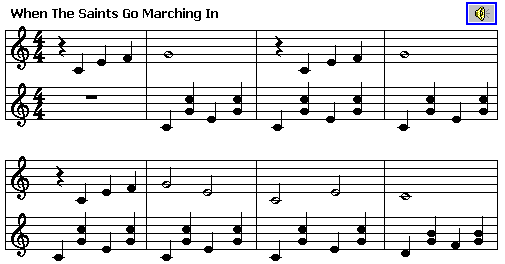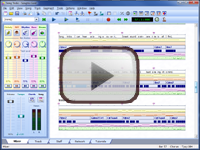(5.4) Bar/Measure Divisions
As mentioned earlier, staff notation is not written as one long stream of musical note symbols. Instead, it is divided into chunks called bars or measures.
Both terms mean the same thing. In American music 'measure' is more commonly used, while 'bar' is preferred in other English speaking countries. Generally, musicians should be acquainted with both terms. For these tutorials, we will use 'bar'.

ChordWizard products such as Songtrix can use either the term bar or measure. Once you have selected your preference, the entire workspace is updated to use your preferred term.
Dividing music into bars provides regular reference points for identifying locations within a piece of music. It also makes written music easier to follow, since each bar of staff symbols can be read and played as a batch, helping musicians to avoid becoming lost or out of time.
The most obvious place to put the bar divisions in written music is on each repetition of the meter, and this is exactly what happens.
Let's revist the theme of the Skater's Waltz from the previous topic, and see how it would be divided into bars when written on staff lines. You may notice three notation marks used here that have not yet been explained.

The 3/4 symbol appearing after the first treble clef is the time signature. It tells us that the meter of the music has a three-beat rhythm, where the length of each beat is written as a quarter-note. If we add up the lengths of the notes in each bar, we will get a total value of three quarter-notes. You can check this.
A dot has been placed after each of the notes which have a length of three beats. Recall that we have a symbol for a whole-note (four beats) and a half-note (two beats), but not a three-quarter-note. Placing a dot after any note symbol extends it by an extra half of its length, so in this case, a half-note with a dot becomes the three-quarter-note that we need.
Finally, there are some long notes in this piece which should last for six beats. However these are split by our three-beat meter, forcing us to put a three-quarter-note in each of two bars. So we need to use a curved line called a tie to rejoin the two parts and make clear that they are really a single long note.
Music for more than one instrument can be notated by using additional staves running in parallel to the first one. In these cases, the bar lines join the staves together on each row to keep the timing coordinated and make the whole arrangement clearer.
Let's add a simple accompaniment to the passage from When The Saints Go Marching In (that we first saw in the previous topic).

As you might expect, this piece begins with a 4/4 time signature, telling us that each bar contains four beats, where a beat is a quarter-note in length. Both parts need their own time signature, but only at the start, not on each line as with the clef.
Notice how the notes of each part are horizontally aligned with each other. In other words, notes from each part that are played at the same time appear directly above or below on the other stave. It is very important to keep the timing coordinated like this in multipart scores.
There are also a couple of new symbols appearing here. In the melody part there are squiggles in the first, third and fifth bar, and in the accompaniment part there is a rectangular block in the first bar. Perhaps you can already guess what they are for?
They are called rests and they indicate when no notes are played. Remember that the length of all symbols in a bar must add up to the total value (in this case four quarter-notes) so rests are needed to fill the gaps and keep the timing accurate, especially in multipart scores.
As with note symbols, there are many different lengths of rests. Let's have a look at them.
|
Topic 63 of 117
| ||
Bring these music concepts to life with the free Songtrix Bronze Edition as you create songs from chords and scales.
Then publish and share your ideas with the other musicians you meet on the ChordWizard Network.
Have questions? Join the ChordWizard Network and post them in the Music Theory forum for answers and discussions on your topics of interest.








